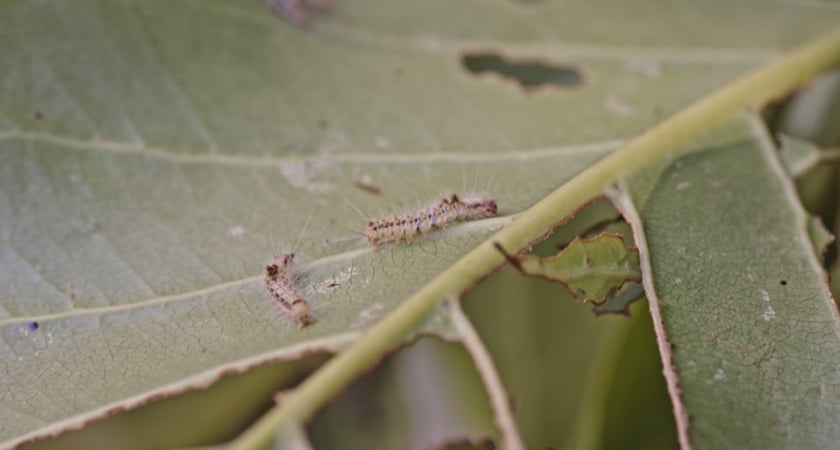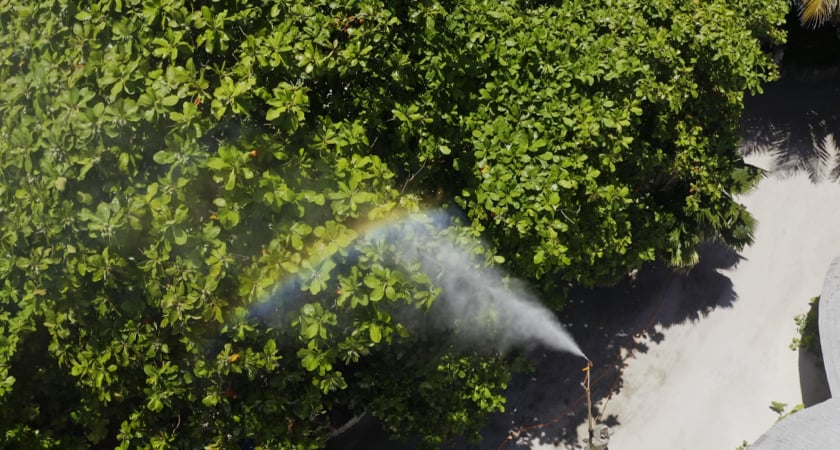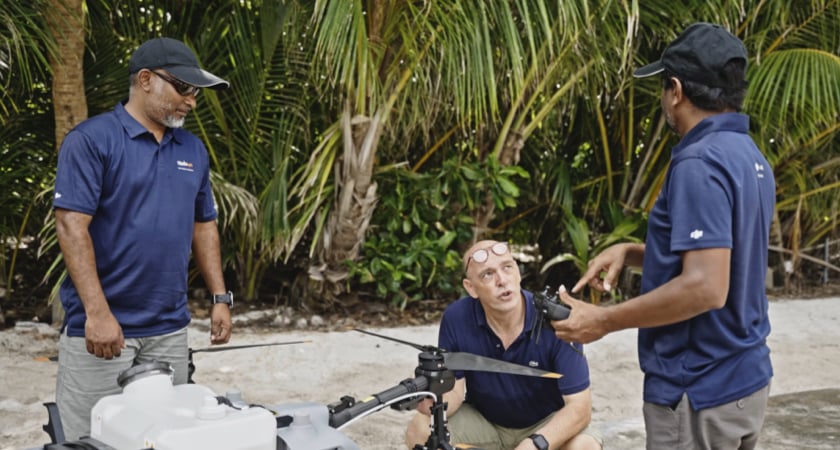All over the world, DJI’s agriculture drones enable farmers to work smarter and improve the sustainability of their operations. The same platforms are also being used in groundbreaking entomological projects. Dr. Knols is best known for his work tackling malaria and mosquitoes. But he’s now in the Maldives combatting a very different pest with DJI’s latest and greatest spraying drone, the Agras T30.
The positive impact of DJI’s agriculture drones is difficult to overstate. All over the world, every flight enables farmers to work smarter and improve the sustainability of their operations. But you may not know that the same platforms have been used for a series of groundbreaking entomological projects. In 2019, Dr. Bart Knols showed that drones can play a central role in the fight against malaria in Tanzania. Now, Dr. Knols has a new target 4,000 km to the east. He’s in the Maldives combatting a very different pest with DJI’s latest and greatest spraying drone, the Agras T30.
Introducing the hairy caterpillar
Don’t be fooled by its innocuous name and fluffy exterior. The hairy caterpillar (Euproctis fraterna) is a bug that poses a serious threat to everyday life in the Maldives. The scenic island chain in the Indian Ocean has emerald waters and a thriving tourism industry. But hordes of these insects are devastating the local Indian Almond trees, a critical species at the heart of the islands’ ecosystem.

The second aspect of the threat is connected to public safety. The hairs of these caterpillars contain a powerful toxin that causes severe rashes and blistering of your skin. They are carried on the wind and exposure is common for locals and tourists. Severe cases can require antihistamine shots or even evacuation to a hospital; enough to turn a trip to one of the world’s most romantic destinations into a vacation from hell. The number of these cold-blooded caterpillars is on the rise as the climate warms, and they are increasingly disrupting the tourism upon which the islands rely.
The impact of tourism & finding the right kind of intervention
To protect guests and staff, resorts across the Maldives are taking steps to keep hairy caterpillars at bay. Central to those efforts is the spraying of Indian Almond trees with pesticides. Manual spraying consists of unwieldy barrels of pesticide and gas-powered spraying poles. It’s crude, inefficient, and time-consuming. And because the caterpillars live high in the canopy of the trees, it’s not easy to target infestations with accuracy - especially when spraying from below. The result is hundreds of liters of pesticide wasted and huge collateral damage to the island ecosystem. The situation has got so severe that many resorts are simply cutting down their trees, a practice that also has disastrous consequences for the islands’ sustainability.

It’s hard to overstate the importance of these trees to the Maldives. Dr. Knols explains that the landmass of the islands is effectively made out of a porous combination of coral and fish waste. “It's a very loose structure that's being held together by the roots of vegetation,” he says. “If you start chopping down trees, then you lose that benefit of the roots keeping everything together. But some resorts are seeing infestations get so heavy that they simply don't have another option, which leads to a cascade of negative effects.”
The scale of the hairy caterpillar plague differs across the Maldives. On unpopulated islands, the pests are present in much smaller numbers - a phenomenon that suggests human actions are somehow tipping the natural balance out of kilter. Ironically, it might be that widespread pesticide spraying - typically targeting mosquitoes - may instead be wiping out natural predators of the caterpillars and allowing their numbers to bloom; that in trying to keep tourists happy, traditional pest control efforts are making the situation worse. Whatever the cause, these caterpillars continue to be a nuisance and threaten the islands’ reputation as a leading vacation destination. Enter Dr. Knols, who has been tasked by Soneva Resorts to find a solution to the hairy caterpillar problem that’s in keeping with the company’s eco-friendly ethos.
“To date, the response on every single island has been to spray large volumes of pesticides or chop down entire trees. That's how far we have got with this problem, which is ridiculous,” he says.

Adding drones & AI into the equation
Dr. Knols’ work in Tanzania is proof that with drones, pesticides can be distributed more efficiently and accurately compared to manual spraying. And compared to rice paddies in Africa, hairy caterpillar infestations high up in the Indian Almond canopies are a natural fit for the technology. The aim is to develop a more targeted approach that will reduce the overall amount of pesticide applied.

The drone that’s been selected for Dr. Knols’ pilot is the new Agras T30, a heavy-duty, 30-liter capacity platform that takes aerial spraying efficiency to new heights. Following a meeting at AirWorks 2022, Dr. Knols is enlisting the help of researchers from McGill University, Canada. The aim is to eventually incorporate multispectral data and AI to make every spraying mission as targeted as possible.
“Ideally we want to seek out infestations in the trees at a very early stage. We don’t want to wait until we’ve got large caterpillars chewing up entire leaves because by then they have big hairs and the problem has already started,” says Dr. Knols. “We want to be ahead of the game, which means using multispectral analysis to monitor infestations.”
As soon as pests start chewing on a leaf, its biochemistry changes - even with tiny caterpillars at an early stage of their development. One of the challenges for Dr. Knols and the McGill researchers in 2023 will be to gather multispectral samples at various stages of infestation to build a model that can recognize the severity of the situation in real time.
“So the idea is that we will be spraying when the problem is not even there yet, skipping trees that don’t have any caterpillars on them and using minimal amounts of pesticide. It will certainly be an interesting contrast with what we do at the moment.”
It’s expected to take almost a year to develop and train a model to recognize infestation sites. But while that’s in the works the Agras T30 will still provide a significant upgrade compared to manual spraying. The platform will be used to dispense a mist of neem oil - a botanical pesticide - mixed with a small amount of cypermethrin, exactly where it’s needed.
Smarter spraying & the role drones could play in the future
This more targeted approach is expected to be well received by environmentally-minded tourists. “Visitors expect things to be environmentally friendly, and as a result of that, the management of resorts are becoming more amenable to adopting new approaches rather than spraying entire jungles,” says Dr. Knols. ”If a resort wants to portray itself as being eco-friendly but the first thing guests see when they arrive is fogging against mosquitoes that kills everything it touches, there are going to be complaints. We are very early but there's certainly an interesting market that will open up.”

Should this pilot be a success, it may not be too long before resorts in other countries impacted by the hairy caterpillar, which include India, Bangladesh, Pakistan, and Seychelles, also seek to modernize their approach.
“It takes time before this sort of method hits the mainstream pest control market. People live with dogmas and to change the market and the attitude of people that are involved takes time,” says Dr. Knols. “But I think the momentum certainly is there. The world is starting to realize that we not only have problems with climate change, but we have major problems with the collapse of biodiversity globally. And we simply have to move away from the way we have done things in the past. We have no choice.” - Dr. Bart Knols
In the not-too-distant future, Dr. Knols envisages a time when even smarter solutions could be brought to bear against the hairy caterpillar. He cites a concept he is exploring that would disrupt the lifecycle of the insect in a more subtle way than spraying its habitat with pesticides. The ambitious idea is to synthesize the female hormones of the Euproctis fraterna moth, before using a small drone to fly with that scent through the jungle like the Pied Piper, leading a trail of male moths into traps.
It may sound like a solution straight out of science fiction, but DJI platforms are increasingly enabling these kinds of groundbreaking agricultural and entomological projects.
Explore the potential of the Agras T30
With its mammoth 30-liter spraying tank and the ability to cover 40 acres per hour, the DJI Agras T30 sets a new standard for the precision spraying of pesticides and fertilizers. Farmers around the world can now tap into a suite of DJI platforms and smart agriculture solutions to reduce fertilizer use and increase yield with data-driven operations.


.png?width=300&name=HS%20-%20Featured%20Images%20(7).png)
-1.png?width=300&name=HS%20-%20Featured%20Images%20(5)-1.png)
.png?width=300&name=Stormpoint%20(1).png)
